Imaging device
a technology of imaging device and lens, which is applied in the direction of instruments, focusing aids, lenses, etc., can solve the problems of increasing manufacturing cost and increasing manufacturing cost, and achieve the effect of dramatically increasing the number of taken images at different focal distances that are simultaneously obtainabl
- Summary
- Abstract
- Description
- Claims
- Application Information
AI Technical Summary
Benefits of technology
Problems solved by technology
Method used
Image
Examples
first embodiment
[0050]FIG. 1 is an external perspective view of an imaging device 10 (imaging device) according to the present invention. As depicted in FIG. 1, a taking lens (multifocal main lens) 12, a stroboscope 18, and others are arranged on a front surface of the imaging device 10, and a shutter button 38-1 is provided on an upper surface thereof. L1 denotes an optical axis of the multifocal main lens 12.
[0051]FIG. 2 is a block diagram depicting an embodiment of an inner structure of the imaging device 10.
[0052]This imaging device 10 records a taken image in a memory card 54, and has an imaging optical system for a so-called plenoptic camera, with a multifocal microlens array 14 provided between the multifocal main lens 12 and a CMOS-type image pickup element (image sensor) 16. The operation of the device as a whole is controlled in a centralized manner by a central processing unit (CPU) 40.
[0053]The imaging device 10 is provided with an operating unit 38 including the shutter button 38-1, a ...
second embodiment
[0098][Second Embodiment of Multifocal Microlens Array]
[0099]FIG. 8 is a diagram depicting a second embodiment of the multifocal microlens array.
[0100]A multifocal microlens array 114 has two microlens groups 114a and 114b with different focal lengths, and each lens is formed so as to have a one-to-one correspondence with each light-receiving cell 16a of the image sensor 16.
[0101]Since each lens of the multifocal microlens array 114 has a one-to-one correspondence with each light-receiving cell 16a of the image sensor 16, a microprism array 110 is provided as a control device for restricting the direction of light beams incident to each light-receiving cell 16a.
[0102]That is, the microprism array 110 is provided on a front surface (a multifocal main lens 12 side) of the multifocal microlens array 114. The microprism array 110 has two types of prism groups 110a and 110b which refract incident light beams in different refracting directions. With this microprism array 110, the positio...
third embodiment
[0113][Third Embodiment of Multifocal Microlens Array]
[0114]FIG. 11 is a side view depicting a third embodiment of the multifocal microlens array. A multifocal microlens array 214 depicted in FIG. 11 has two microlens groups, that is, a microlens group 214a and a microlens group 214b with different lens positions (heights) in an optical axis direction. With this, the microlens group 214a and the microlens group 214b have different focal distances.
[0115][Number of Lenses of Microlens Group of Multifocal Microlens Array]
[0116]FIG. 12 is a graphical overview of an embodiment of weighting the number of lenses of two microlens groups with different focal lengths of the multifocal microlens array.
[0117]A multifocal microlens array 314 depicted in FIG. 12 has a microlens group 314a and a microlens group 314b with different focal lengths. The microlens group 314a and the microlens group 314b each have a different number of lenses. For one lens of the microlens group 314b, eight surrounding ...
PUM
 Login to View More
Login to View More Abstract
Description
Claims
Application Information
 Login to View More
Login to View More - R&D
- Intellectual Property
- Life Sciences
- Materials
- Tech Scout
- Unparalleled Data Quality
- Higher Quality Content
- 60% Fewer Hallucinations
Browse by: Latest US Patents, China's latest patents, Technical Efficacy Thesaurus, Application Domain, Technology Topic, Popular Technical Reports.
© 2025 PatSnap. All rights reserved.Legal|Privacy policy|Modern Slavery Act Transparency Statement|Sitemap|About US| Contact US: help@patsnap.com



